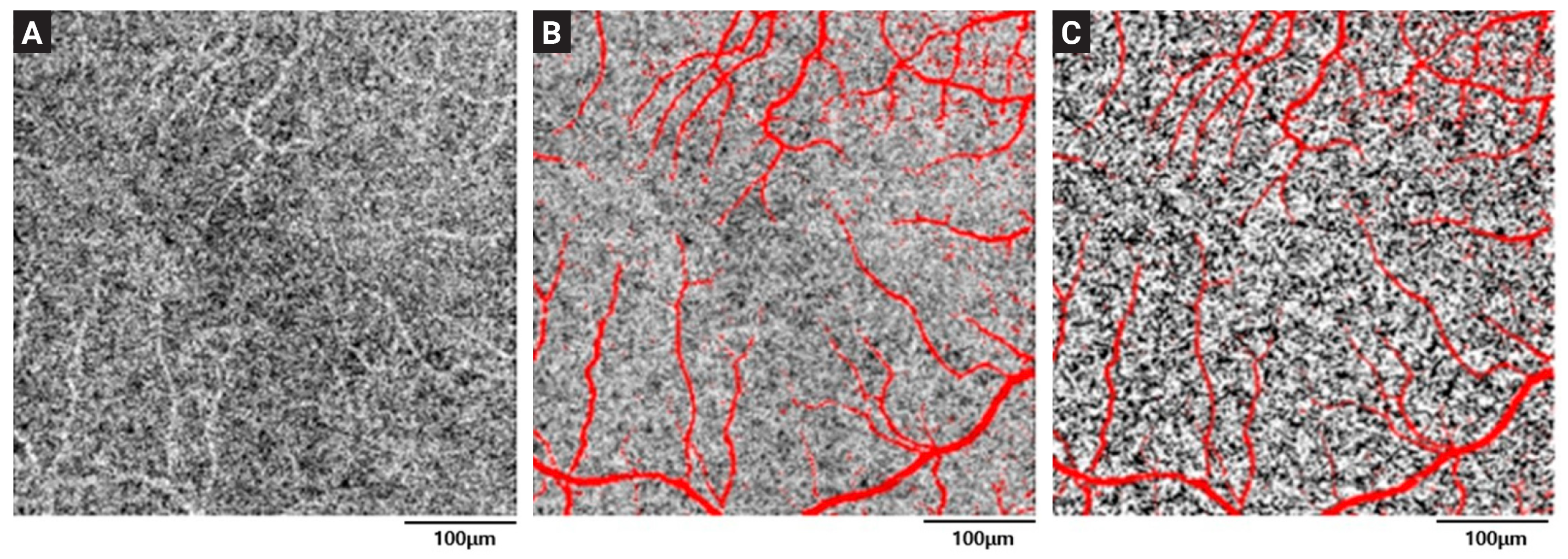With the prevalence of myopia continuing to increase significantly globally, many products have been designed to control the progression of the condition. Though not yet available in the United States, defocus-incorporated multiple segments (DIMS) spectacle lenses have shown a mitigating effect. A recent study sheds more light on how to predict response to this modality.
Researchers in China investigated choroidal and ocular biological variables that influence axial length elongation in children wearing DIMS spectacle lenses and found that larger choriocapillaris flow void area at baseline—a metric possible on OCT-A devices—may help to predict axial elongation in myopic eyes. This flow void, or absence of OCT-A signal, typically indicates absence of blood flow or flow that is below the detection sensitivity of the OCT-A system.
 |
| Flow voids are areas where blood flow signal becomes lower. In other words, the flow void refers to the non-white part of a black/white binary image, which can be considered as the non-flow part of the choriocapillaris. Image shows (A) a choriocapillaris angiogram, (B) Projection mask (red pixels) derived from the superficial and deep angiograms superimposed on the field, and (C) Binarization of choriocapillaris layer to reveal flow dynamics. Photo: Kim DS et al. J. Pers. Med. 2022 (12): 839. Click image to enlarge. |
A total of 106 myopic children ages seven to 14 years were included and all had a one-year follow-up. Participants were divided into two groups according to the increase in AL at one year, either rapid (>0.2mm) or slow (≤0.2mm) elongation groups. Cycloplegic autorefraction and axial length were measured at baseline and after six and 12 months. The area of choriocapillaris flow voids and choroidal thickness at baseline were measured with OCT-A.
To the best of the authors’ knowledge, they believe they found for the first time a predictive effect of flow void area on myopia control in children wearing DIMS lenses, suggesting that a low choriocapillaris flow at baseline may contribute to rapid myopia progression.
In estimating axial elongation, the flow voids area alone demonstrated an area under the curve of 0.672, and that of flow voids area and other ocular variables was 0.788. The average one-year axial length increase with DIMS lenses was approximately 0.25mm.
“We found that the flow voids area was a potential predictor of axial elongation when wearing DIMS lenses; specifically, a smaller area, which reflects more sustained choriocapillaris perfusion, may imply slower myopia progression,” the authors explained in the study for the British journal Eye. “We also found that for children wearing DIMS lenses, older age, initially less myopic eyes, larger pupil size and steeper corneal curvature were protective factors for myopia control effects.”
Previous studies of high myopia in adults showed a greater flow void area in individuals with high myopia than in those with low or moderate myopia. In this study with younger adolescents, a greater flow voids area at baseline indicated more axial growth during the next year.
“The causal relationship between the flow voids area and the progression of myopia remains to be further elucidated, and we still do not know whether a lower flow voids area would lead to rapid myopia progression or vice versa,” the authors wrote in their paper.
Li X, Hu J, Peng Z, et al. Association between choriocapillaris perfusion and axial elongation in children using defocus incorporated multiple segments spectacle lenses. Eye. June 27, 2023. [Epub ahead of print]. |

